Key points: What causes novae, and type I and type II supernovae; origin of elements heavier than helium
A nova is a star that brightens suddenly by 100 to 10,000 times in a single day.
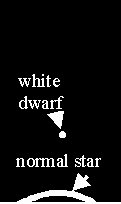 |
Novae are frequently (perhaps always) members of binary systems where the more massive star evolves more quickly and becomes a white dwarf. The less massive star loses some of its hydrogen-rich outer atmosphere to the white dwarf where it collects. (adapted by G. Rieke from J. Blondin, http://wonka.physics.ncsu.edu/~blondin/AAS/) |
are stars that end their lifetimes in a violent
nuclear explosion during which a single star can become as bright as
an entire galaxy like the Milky Way. When one explodes nearby, the appearance of a bright
new star is an awesome sight![]()
| Two Types of Supernovae
By examining both the light curves and spectra of supernovae, we have learned that there are two very different causes for a supernova explosion.
from J. Kaler via http://www.chapman.edu/oca/benet/intro_sn.htm
|
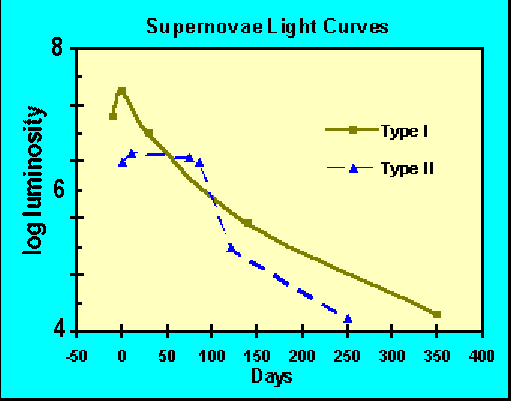 |
Type I:
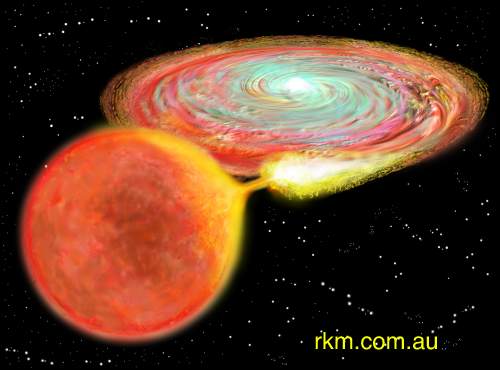 |
The "Type I" supernovae arise
when the white dwarf star member of a binary system accretes so much matter from its
companion that it is tipped over the 1.4M |
Type II:
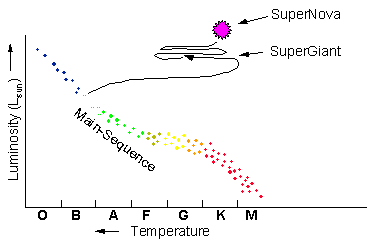 |
The "Type II" supernovae are the
result of a massive star consuming all of its nuclear fuel and then exploding. The black
line traces the evolution of a massive star schematically, until it reaches the supernova
stage. (from G. Smith, http://casswww.ucsd.edu/public/tutorial/SN.html)
|
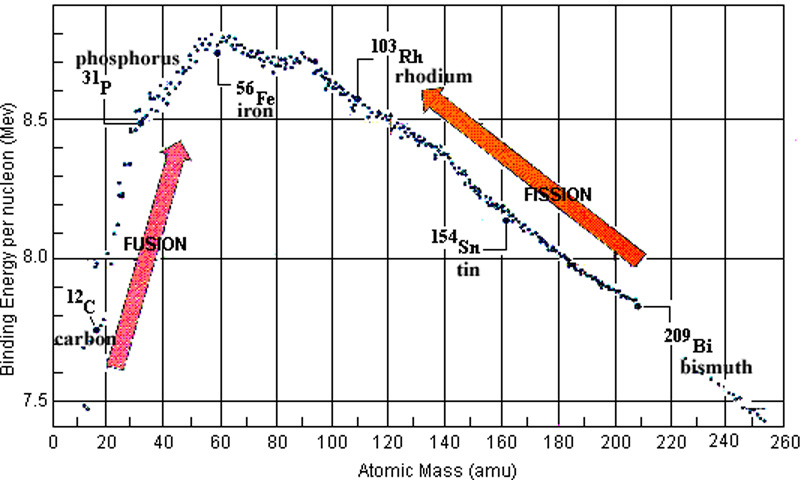 |
This figure shows how the greatest binding energy per nuclear
particle (nucleon) occurs for iron. (from Bodner Research Group,
Purdue University, http://chemed.chem.purdue.edu/genchem/topicreview/bp/ch23/modes.html.)
Thus, when the stellar core becomes solid iron, there is no fusion reaction available to produce energy to keep the core hot and maintain the pressure that resists gravity; the iron core collapses in just a few seconds to a neutron star (or black hole). Nuclear energy can be produced by elements with heavier nuclei than iron, but only by fission, where the nucleus splits into lighter ones and releases the energy that way. This only works well for nuclei much more massive than iron, and stars have no way to build such elements in their core reaction cycles. |
Core Collapse and Supernovae
With the support from the core removed, the upper layers of the star collapse. When they hit the new, very hard neutron-star core, they bounce and send material crashing back up through the still-falling layers (see simulation below). The result is a rapid increase in temperature to several billions of degrees.
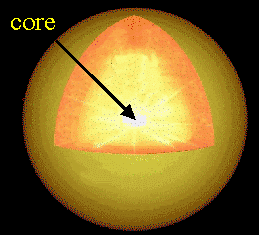 |
Core collapse: We zoom in on a tiny region (300 km across) with the
stellar core at the lower left corner and then watch the star fall in onto the neutron
star core. During the first 0.4 sec of the core collapse, many neutrinos are formed
leading to a burst of neutrino emission. Gravitational waves are also likely to be emitted
from the rapidly collapsing core but have never been observed. Eventually the surrounding
material becomes so hot it begins to boil and starts the explosive outwards shock that
ignites the hydrogen in the outer layers, causing the huge energy release in the
supernova.(Animation adapted by G. Rieke from A. Burrows, Univ. of
Arizona, full movie at |
| If we look in high time resolution the first fraction of a second in the stellar core is very chaotic and leads to lots of structure - the colors code the level of local organization of the material, which reflect the turbulence. This behavior can be reflected by non-spherical ejection of material in the explosion. (from NASA Visualization Explorer https://svs.gsfc.nasa.gov/cgi-bin/details.cgi?aid=11735, Christian Ott) | 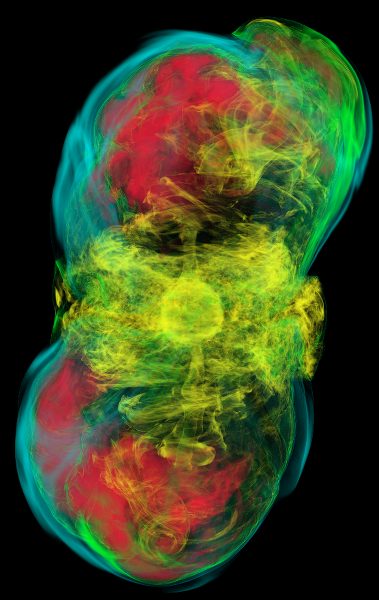 |
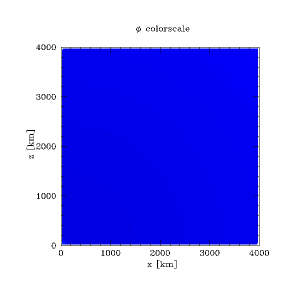 |
This simulation shows what happens in the upper layers of the star as the shock passes through them. The neutron star core is at the lower left corner. The huge release of energy causes much of the hydrogen to fuse into helium, releasing huge amounts of energy that create the visible supernova. So much energy is released that the material in the star can react and produce all the elements heavier than iron, none of which can be produced during the previous life of the star. Animation from Tetsuya Shimizu. |
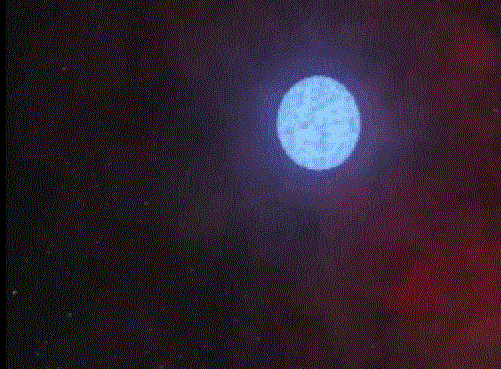 |
Here is a more distant overview of the process |
 |
And how it might look from a desolate planet orbiting the star, with the optimistic assumption that the observer would live long enough to see the pulsar emerge! Animation from NASA/HEASARC |
After collapse, the stellar brightness increases dramatically (by a least at factor of 10,000)
In the end, all the outer layers of the star are blown away, leaving only a black hole or neutron star -- the latter may send out searchlight beams of light that sweep the sky as it spins and can appear to us as a pulsar.
The properties of a Type I explosion differ from a Type II because the white dwarf never synthesized any elements heavier than carbon in its core.
What becomes of any core material left from a supernova explosion?
1) If the core that remains has a mass less
than 3M![]() , it will
become a neutron star/pulsar like the Crab pulsar.
, it will
become a neutron star/pulsar like the Crab pulsar.
2) If the core is too massive, it will become a black hole because not even neutron degeneracy pressure will be able to resist the force of gravity.
Test your understanding before going on![]()
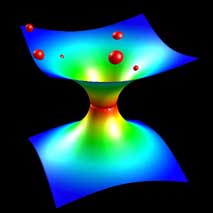
"Embedding" diagram, showing how a black hole distorts space/time, from C. Pickover, http://sprott.physics.wisc.edu/pickover/graphcp.html |

Painting of Crab supernova, Chaco Canyon http://www.colorado.edu/Conferences/chaco/tour/blanco.htm |
|
Click to return to syllabus |
||
| Click to return to Stellar Black Holes | hypertext |
Click to go to Supernova Remnants |